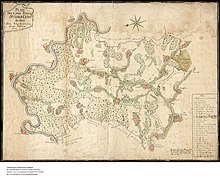Stüber Zent
The upper Zent , also Stüber Zent or Stüber Cent or Reichartshauser Zent , was an administrative unit that existed from the Middle Ages and was subordinate to the Electoral Palatinate Oberamt Heidelberg and an imperial judicial district, which roughly included the area of the Kleiner Odenwald except for its southwestern part and the seat their main court in Reichartshausen .
history
Reichartshausen was probably already settled in the Alemannic period , i.e. between the 3rd and 6th centuries AD. Due to its great age, the place was already important as a place of justice early on, which was retained in the surrounding area in the 14th century after the transition to the Electoral Palatinate and the expansion of the Electoral Palatinate area. In 1360, Emperor Charles IV pledged the Stüber Zent to the knight Engelhard I von Hirschhorn , who thus exercised the high level of jurisdiction on an imperial mandate. In 1378, however, his son Engelhard II , who was under imperial ban, had to cede this authorization to the Count Palatine. Zentrecht was held in so-called wisdoms and customers . It regulated u. a. also measures, weights, wages, veterinary and moral police. The subjects were informed of this by scouts who traveled around on behalf of the sovereign and read the regulations. The respective mayors had to agree to this. The high judiciary also punished crimes. Appealing to a spiritual court was forbidden. It was also forbidden to forge the weight of bread and buy mangy cattle .
In 1416, the younger brother of Elector Ludwig , Count Palatine Otto in Mosbach , raised a claim to the Stüber Zent due to differences in interpretation. Since the wisdom showed Ludwig as the rightful owner, he renounced. The Central Court last met in the "Bürgersaal" of the old town hall in Reichartshausen, which was demolished in 1951. The last execution in the Stüber Zent took place on October 12, 1780. The time of the Stüber Zent ended with the Reichsdeputationshauptschluss of 1803, through which the office of Heidelberg fell to Baden and was subordinated to the administration there.
The Zenten administered zentgraves , mostly farmers, and zentschöffen, often the village schools. A Zentgraf who called himself Martin von Dudenzelle has come down to us around 1416. However, the meaning of titles and powers changed over time. Central communities were obliged to the central lord and had to provide him with protection and escort, hunters and drivers for wolf hunting and indulgence for chopping wood. When they reached the age of 18, central citizens took the oath of subjects in central courts.
In the local law of Epfenbach in 1770 the following passage was found: There are no Jews or Menonists there, measured the places as intended to belong to Stüber cents and have the age-old privilege over others, the duty-free and no Jews to tolerate for living and protection at home . It is unclear why there were no Jews in Stüber Zent, especially since the von Hirschhorn gentlemen welcomed the Jews in a friendly manner when they were accused of poisoning wells from other places in the course of the plague epidemic and were chased away.
The Stüber Zent also exercised local authority in some of the places belonging to the area. The name "Stüber Zent" is said to be derived from the court in Reichartshausen on the Stiefelberg (formerly: Stübelberg), where the gallows and execution block were. The older spelling Cent meant that the Cent included around 100 families. In the more recent spelling of Zent (of ten) one suspects, among other things, that the Zent comprised about ten localities.
Places of the Stüber Zent
The following places belonged to Stüber Zent: Moosbrunn (local rule Niederadel), Schönbrunn (local rule 1349), Haag (local rule 1419), Schwanheim with Unterallemühl (local rule partly 1349, 1410–1499 Pfalz-Mosbach, partly 1419, e.g. T. Niederadel), Neunkirchen (local authority partly 1349, 1410–1499 Pfalz-Mosbach, partly 1419, partly 18th century with Zwingenberg), Neckarkatzenbach (local authority with Minneburg 1349, 1410–1499 Pfalz-Mosbach), Guttenbach (local rule 1349, Pfalz-Mosbach 1410 to 1499), Epfenbach (local rule Niederadel), Reichartshausen (local rule Niederadel), Michelbach (local rule Niederadel), Unterschwarzach , Oberschwarzach (local rule with Schwarzach Castle in 1419), Aglasterhausen (local rule Niederadel, from 1632 diocese of Worms), Breitenbronn (local rule until 1653 Niederadel), Daudenzell (local rule Niederadel), Helmstadt (local rule Niederadel), Asbach (local rule until 1560 Niederadel), Flinsbach (local rule Niederadel) and Bargen (O Rtsherrschaft Niederadel, from 1632 Hochstift Worms), also the Stüber Zentwald.
literature
- Alfred Caroli: From the Stüber Cent - Torn ties . In: Kraichgau. Local history research in the district of Sinsheim , taking into account its immediate neighboring areas. Edited by the local history working group in the Sinsheim district and the Sinsheim district office. Episode 1/1968, pp. 100-104
- Alfred Caroli: Two memorable inspections of the border of the Reichartshauser (Stüber) Cent in the years 1712 + 1747 . In: Kraichgau. Local history research in the district of Sinsheim, taking into account its immediate neighboring areas. Edited by the local history working group in the Sinsheim district and the Sinsheim district office. Episode 2/1970, pp. 102-111
- Otto Kissel: Aglasterhausen, history of a rural community . Geiger-Verlag, Horb 2000 ISBN 3-89570-641-8
- Mosaics of local and local history. Boundary stone rediscovered - witness from the Stüber Cent from 1780 , in: Rhein-Neckar-Zeitung of April 13, 1982
- Günter Wittmann: The Reichartshauser or Stüber Zent. In: Kraichgau. Contributions to landscape and local research. Edited by the Heimatverein Kraichgau . Episode 9/1985, pp. 34-48




